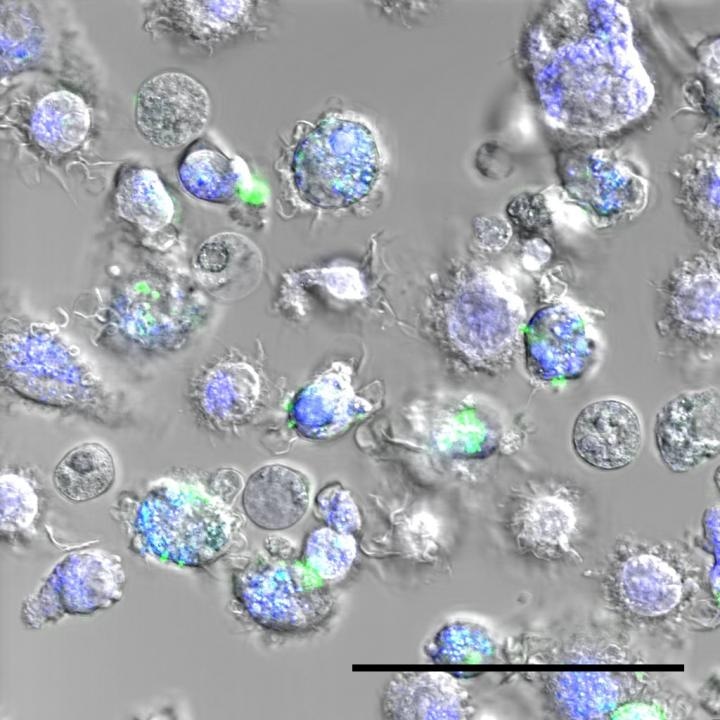Feb 6 2017
 These are macrophages with, in green, nanoparticles. (CREDIT - �Laboratoire Bourquin - UNIFR/UNIGE)
These are macrophages with, in green, nanoparticles. (CREDIT - �Laboratoire Bourquin - UNIFR/UNIGE)
Tiny, virus-sized elements or nanoparticles created in laboratory conditions are gaining in popularity in the field of biomedicine. This quickly-evolving technology provides hope for several medical applications, both for therapies and diagnosis.
For instance, in oncology the increasing amount of research indicates that due to nanoparticles, before long treatment will become less painful, more effective, and more precise. However, the way nanoparticles reacted with the immune system was still not clear and was unpredictable until recently, restricting their potential medical use.
A collaborative research team from the universities of Geneva (UNIGE) and Fribourg (UNIFR), Switzerland, is close to finding an answer. They have developed a rapid screening technique to choose the most promising nanoparticles, accelerating the progress of future treatments.
Within a week, they are able to establish whether the nanoparticles are compatible with the body or not -- an analysis that earlier took many months to complete. This discovery could possibly lead to the fast, safe and less expensive development of nanotechnology for use in medicine. The details of the discovery are illustrated in the Nanoscale journal.
A nanoparticle measures between 1 and 100 nm, which is roughly the size of a virus. Their size attribute opens the door for potential use in a broad range of medical applications: to serve as markers for diagnosis, for instance, or to deliver therapeutic molecules to a precise spot in the body where the drug is required to act.
However, before being used in the medical field, nanoparticles will have to prove two things – that they are safe for use in human body; and have the capacity to sidestep the immune system to achieve the desired effect.
Researchers can spend years developing a nanoparticle, without knowing what impact it will have on a living organism. So there was a real need to design an effective screening method that could be implemented at the beginning of the development process. Indeed, if the nanoparticles aren't compatible, several years of research were simply thrown away.
Carole Bourquin, Professor, UNIGE
Macrophages Orchestrate the Immune Response
When any foreign element enters the body, the immune system is triggered. Macrophages, found on the front line, are large cells that “ingest” the intruders and activate the immune response. Nanoparticles entering the body will also face these cells. The way macrophages respond to the nanoparticle under study then predicts the product’s biocompatibility.
When you begin to develop a new particle, it's very difficult to ensure that the recipe is exactly the same every time. If we test different batches, the results may differ. Hence our idea of finding a way to test the three parameters simultaneously -- and on the same sample -- to establish the product's biocompatibility: its toxicity, its ability to activate the immune system, and the capacity of the macrophages to ingest them.
Inès Mottas, First Author
The perfect medical nanoparticle should therefore not be toxic, meaning that it should not kill the cells; should not be fully ingested by the macrophages, so that it keeps hold of its power to act; and should restrict the activation of the immune system in order to avoid unfavorable side-effects.
Evaluating the Three Key Elements Simultaneously
Until now, assessing the biocompatibility of nanomaterials was a laborious task that took many months and posed reproducibility issues, as not all the tests were conducted using the same batch of particles. Flow cytometry was used by Professor Bourquin and her team to arrive at a diagnosis on the three crucial elements in a safe and standardized format, and in record time.
The macrophages are brought into contact with the nanoparticles for 24 hours, and are then passed in front of the laser beams. The fluorescence emitted by the macrophages makes it possible to count them and characterise their activation levels. Since the particles themselves are fluorescent, we can also measure the amount ingested by the macrophages. Our process means we can test the three elements simultaneously, and we only need a very small amount of particles. We can obtain a comprehensive diagnosis of the nanoparticle submitted to us in two or three days.
Inès Mottas, First Author
The technique developed in Geneva and Freiburg is a portion of the research carried out within the National Centers of Competence in Research (NCCR) "Bio-Inspired Materials", and is already a huge success with researchers keen on developing new particles.
It focuses their investigations by enabling them to choose the most promising particles quickly. In addition to impacting the financial aspect of research, this new method also restricts the use of animal testing. Also, it is paving the way to the increasingly tailor-made treatment of particular pathologies.
For instance, using the nanoparticles on tumor cells isolated from one patient, it should hypothetically be possible to determine the most helpful treatment. Whether this hypothesis is backed up in practice is something that may be seen in the days to come.